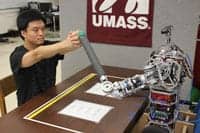
During the case study, researchers say a patient with aphasia and physical disability on one side of the body completed a robot-mediated program of only speech therapy for 5 weeks followed by only physical therapy for 5 weeks in the sole condition. For the sequential condition, the patient reportedly attended back-to-back speech and physical therapy sessions for 5 weeks.
Study authors report that during the experiment, the patient exhibited “notable gains in the frequency and range of upper-limb movements.” The results indicate the patient demonstrated positive gains in verbal expression. The results also suggest the patient exhibited greater improvements in speech and physical function when he engaged in only one therapy than when the therapies were paired in sessions held in secession.
In a recent news release, the university notes that Yu-kyong Choe, PhD, CCC-SLP, study leader, and Rod Grupen, PhD, director of the Laboratory for Perceptual Robotics, UMass Amherst, are in the second year of a $109,251 grant from the American Heart Association. The grant is intended to assess the impact of stroke rehabilitation delivered by a humanoid robot, uBot-5.
The robot is a child-sized unit, comprised of arms and a computer screen through which therapists interact with the client. The robot may hold promise in the treatment of patients in rural areas, researchers say. “A personal robot could save billions of dollars in elder care while letting people stay in their own homes and communities. We’re hoping for a win-win where our elders live better, more independent, and productive lives and our overtaxed health care resources are used more effectively,” Grupen points out. The study is ongoing, the release notes, and will continue to enroll patients recovering from stroke.
[Photo Caption: Computer science doctoral student Hee-tae Jung practicing therapeutic arm movement with a uBot5 personal robot at UMass Amherst.]
[Photo Credit: UMass Amherst]
[Source: UMass Amherst]




